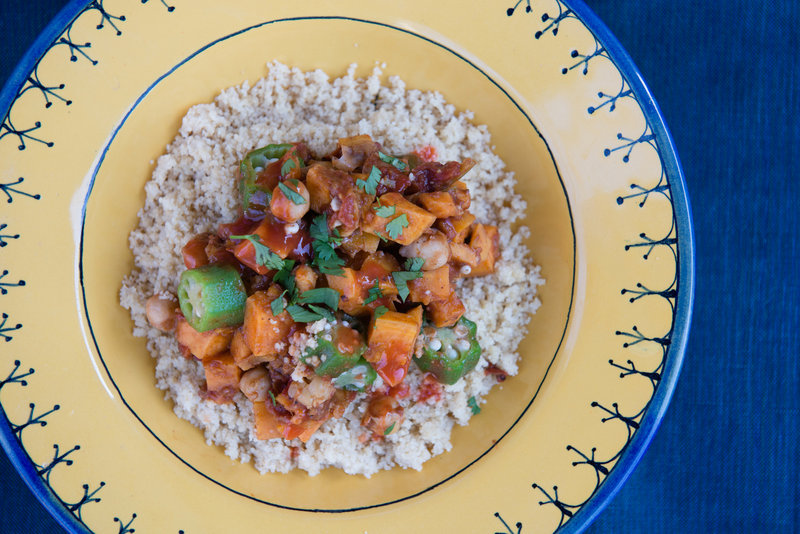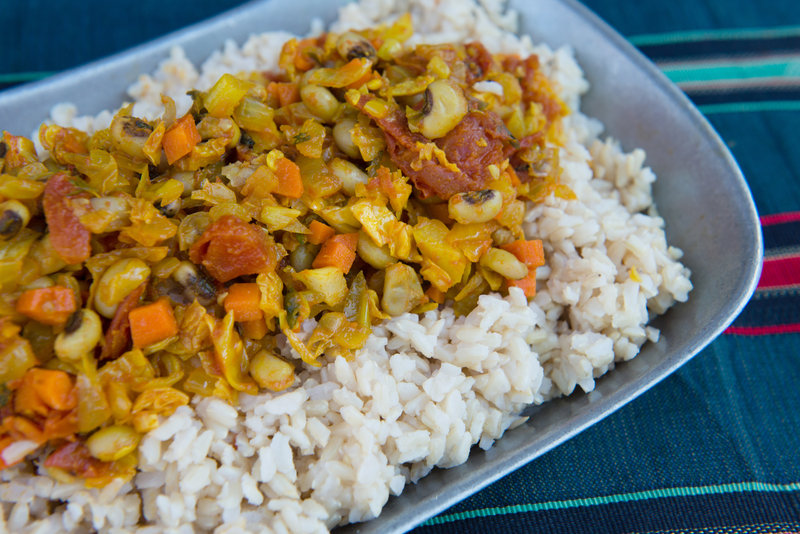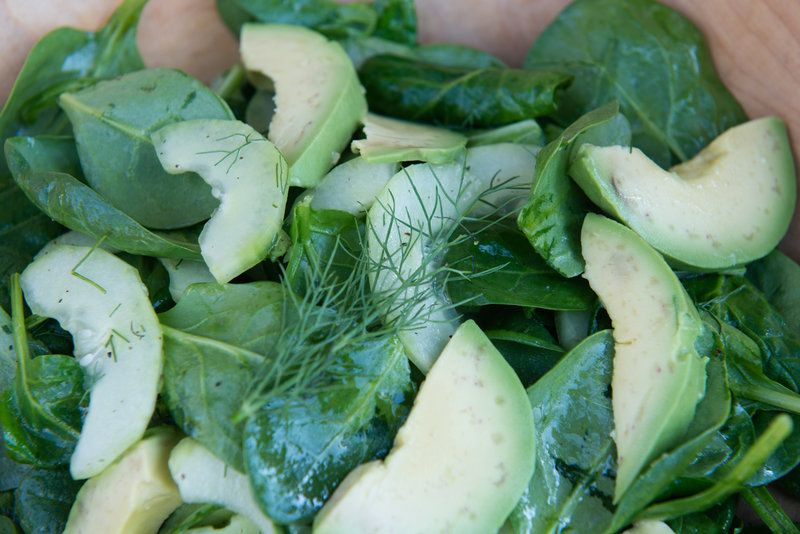This year, between the cake and ice cream in honor of my parents’ recent birthdays, I decided to give them a different kind of gift.
The gift of healthful food.
African food. Food that held a close resemblance to theirs, except with less salt, with no coconut milk and mixed with other healthful, naturally grown fare that they had moved further away from eating since coming to the States from Guyana in the late 1970s.
“Back home, everything is organic,” my dad said as we sat in my parents’ Fort Washington, Md., kitchen. “Most of us back home have a garden.”
Here, “everything is processed, packaged, with fertilizers and preservatives,” Mom said. After more than 30 years as a U.S. citizen, she has had enough time to observe the food industry and change her eating habits to match it. That change was not always for the better.
Early on in my parents’ house, most foods were fresh. After years of living in America and with Americanized kids, they slowly started taking shortcuts. More frozen vegetables, white sugar and fast food started sharing space with the brown rice, cantaloupe and homemade bread that they regularly kept at home as well. What was convenient became more constant.
My motives while visiting them one Sunday evening recently weren’t purely to keep them aging well as empty nesters.
As part of a work assignment last fall, I spent weeks learning why it’s unhealthful to boil collard greens to death, how to make Africans’ jollof rice more colorful and nutritious, and why it’s important to eat the food from my ancestral land: Because the base of the murky, somewhat confusing label of African-American is African. We may come with different heritages, such as African-American or Afro-Caribbean, but we have the same beginning and often the same dietary palate and needs, ones that aren’t always met through Western food culture.
Those lessons were taught by Tambra Raye Stevenson and brought to the District of Columbia by the nonprofit food and nutrition education company Oldways. My colleagues in The Post Food section urged me to take on another challenge: Would my parents eat, and possibly cook, the organic dishes Stevenson had taught me to prepare, opening their minds to a more African approach to food?
The endeavor would be complicated because I, African by way of a not-quite-Caribbean nation, was complicated.
I am the hyphen that sometimes appears between African and American.
Though my parents were born and raised in a South American country with a Caribbean culture, I was born on American soil; my linkage to the United States and its melting pot is embedded in the way I walk, talk and view the world, from music to art. My bond to Africa, though, is less tangible. It comes from the color of my skin, texture of my hair and knowledge absorbed through books and movies.
The middle ground that enables me to feel comfortable in both worlds, African and American, is often food.
After befriending many first-generation Africans at the University of Maryland in College Park, I quickly saw the similarities between their jollof rice, which includes a mixture of vegetables, tubers and sometimes meat, and my family’s “cook-up rice.” I realized I had been eating the Africans’ dodo my whole life but calling it plantain.
Our dishes were kin. We were family.
And as family, we share ownership of the statistics crippling our community: Astronomical rates of obesity, diabetes and heart disease. The Oldways classes were supposed to work against those health risks by teaching students to eat fresh, which my parents often do.
For their meal, I bought fresh carrots, greens, onions and garlic. The necessary chopping meant, for me, a grueling two hours in my kitchen and a cutting board that may be headed to the garbage. But the food smelled and looked delicious. The next day, I arrived at my parents’ house with several Tupperware containers. I was greeted by more fresh food: apples, pomegranate and avocado were on the kitchen table. In a bowl in the sink were plantains, eddoes (a member of the tuber family) and sweet potatoes.
“We making soup,” said my father, his accent and dialect still strong after decades in the States.
My parents are always preparing something. Salted fish and bake (biscuit) for breakfast. Jerk chicken and cook-up rice for lunch. Dinner might be stew chicken and channa (also known as chickpeas), Caribbean chow mein or dry food, which is a kind of soup. Because the international aisle in most grocery stores is limited, Mom and Dad spend Saturdays jumping from store to store.
“We get milk, sugar. We buy rice from the American stores,” Dad said.
Whether I liked it or not, they fed me those carb-heavy meals for lunch when I was a child. They did not dispense Lunchables or the like for us kids. I can’t remember anyone else in fourth grade who carried a Thermos with a hot meal daily, except on the few days when Mom gave me sandwiches made with homemade bread.
Cooking is a way of life in our family. To have their youngest cook for them is proof, in my parents’ eyes, that they raised me right. It’s right up there with going to college and owning a home. A life skill that demonstrates my successful transition into adulthood.
That Sunday, we sat down to dishes from two Oldways recipes: jollof rice with black-eyed peas and collard greens, plus my own baked tilapia. I explained how the rice, mixed with tomatoes and cabbage, was similar to the cook-up rice they’d grown up on, that I had used only a pinch of salt with the greens, and that most of the herbs and spices were fresh.
Their reactions were mixed.
“For a no-salt dish, the rice has a lot of flavor,” said Mom, wearing a faded 1988 T-shirt with a map of Guyana printed on the front. “The onions and the cabbage add a lot of flavor.”
But not enough for Dad.
“They don’t use coconut milk in their food,” he said. “That would add a little to it.”
Two cups of coconut milk, a staple ingredient for West Indian dishes such as peas and rice and cook-up rice, contains 96 grams of fat and 890 calories.
Could he and my mother move away from coconut milk, or at least to the lower-fat version? Probably not; they don’t think the latter tastes as good. They regularly buy it in bulk for me and them.
Could they exclusively use fresh greens and cut out the pre-packaged fare?
Mom: “Yeah, I’d buy more fresh ones if I could get it.”
Dad: “I buy the frozen collard greens. . . . It’s already cut and ready to use.” Again, convenience wins.
Their favorite part of the meal was the tilapia, slathered in a store-bought, “100 percent natural” chipotle sauce. A serving size of 1 tablespoon of the sauce has 80 calories. I probably used five tablespoons on each piece of fish.
I guess transition takes time.
They both scoffed at the idea of taking a class to learn new ways to cook and improve their diet. (“We can cook!” Dad said.) But they were open to reading about it and then trying it out at home.
I might take another stab soon at getting my family to rethink some of our dishes. Right now, the one-meal-at-a-time approach seems best.
SPICY CHICKPEA AND SWEET POTATO STEW
Makes: 8-1/2 cups of stew (about four servings)
This hearty mix of vegetables fills the house with delicious smells as it cooks. If you’d prefer to keep your okra looking green, steam it separately in the microwave just until tender, then stir it into the stew just before serving. Adapted from Oldways, a nonprofit organization that promotes healthful eating and drinking.
FOR THE SPICE PASTE:
6 cloves garlic
1 teaspoon coarse salt
2 teaspoons sweet paprika
1-1/2 teaspoons cumin seed
1 teaspoon cracked black pepper
1/2 teaspoon ground ginger
1/2 teaspoon ground allspice
1 tablespoon olive oil
FOR THE STEW AND COUSCOUS:
1-1/2 pounds sweet potatoes, peeled and cut into cubes
2 cups no-salt-added vegetable broth (may substitute water)
14.5 ounces canned no-salt-added diced fire-roasted tomatoes, such as Muir Glen brand, with their juices
15 ounces canned no-salt-added chickpeas, drained and rinsed
10 ounces frozen/defrosted okra, sliced (may substitute 11/2 cups sliced fresh okra)
1 cup dried whole-wheat couscous
Hot pepper sauce, for garnish
Cilantro leaves, for garnish
For the spice paste: Combine the garlic and salt in a mini food processor or spice grinder to form a coarse puree. Add the paprika, cumin seed, black pepper, ground ginger, allspice and oil. Blend for at least 15 seconds to form a paste. Transfer to a small bowl.
For the stew and couscous: Combine the sweet potatoes, broth, tomatoes and their juices, chickpeas, okra and all of the spice paste in a large saucepan. Bring to a boil over high heat, then stir and reduce the heat to medium-low. Cover and cook for 15 minutes, then uncover and cook for 10 minutes, stirring as needed, until the vegetables are tender.
While the stew is cooking, prepare the couscous according to the package directions.
Divide the cooked couscous among individual wide, shallow bowls. Spoon the stew over the top. Garnish with dashes of hot sauce and the cilantro leaves, if desired. Serve hot.
Per serving: 510 calories, 17 g protein, 102 g carbohydrates, 6 g fat, 1 g saturated fat, 0 mg cholesterol, 730 mg sodium, 16 g dietary fiber, 14 g sugar
JOLLOF RICE WITH BLACK-EYED PEAS
Makes: 7 cups of vegetable and 51/2 cups of rice (six to eight servings)
This version of a tomato-based West African rice dish can be served as a main course or as a side dish with fish. Adapted from Oldways, a nonprofit organization that promotes healthful eating and drinking.
14.5- or 15-ounce can no-salt-added diced tomatoes, preferably fire-roasted, such as Muir Glen brand, with their juices
Water
2 cups uncooked brown basmati rice
2 tablespoons extra-virgin olive oil
2 cups chopped yellow onion
2 or 3 cloves garlic, minced
About 1 cup chopped carrots
About 2 cups chopped green cabbage
2 tablespoons tomato paste, preferably double-concentrated
1-3/4 cups homemade or canned no-salt-added black-eyed peas, drained and rinsed (from a 15-ounce can; see note)
1 teaspoon ground turmeric
1 tablespoon fresh thyme leaves
1/2 teaspoon crushed red pepper flakes
Chopped flat-leaf parsley, for garnish (optional)
Sea salt or kosher salt, for garnish (optional)
Drain the tomatoes and reserve them, straining the juices into a 4-cup measuring cup. Add water as needed to total 4 cups, then transfer the liquid to a large saucepan. Add the rice and bring to a boil over high heat; stir and reduce the heat to medium-low. Cook uncovered for 30 to 35 minutes, until the rice is tender and has absorbed the liquid.
Meanwhile, heat the oil in a large skillet over medium heat until the oil shimmers. Add the onion and garlic; stir to coat, then cook for about 5 minutes until softened. Stir in the carrots and cabbage, tomato paste, drained tomatoes, black-eyed-peas, turmeric, thyme and crushed red pepper flakes. Cover and reduce the heat to medium-low; cook for 4 minutes, until the mixture is thoroughly warmed through and the vegetables achieve the desired consistency.
To serve, divide the rice among individual plates or transfer to a serving bowl. Spoon the vegetable mixture on top. Garnish with the parsley and salt, if desired.
NOTE: To cook the 13/4 cups of black-eyed peas needed for this recipe, place 2/3 cup of dried black-eyed peas in a bowl and cover with water by an inch or so. Let sit for 8 hours, then drain and place in a medium saucepan. Cover with (fresh) water by an inch or so; bring to a boil over medium-high heat, then reduce the heat to medium-low, cover and cook for about 90 minutes, until tender.
Per serving (based on eight): 290 calories, 9 g protein, 53 g carbohydrates, 6 g fat, 1 g saturated fat, 0 mg cholesterol, 50 mg sodium, 7 g dietary fiber, 8 g sugar
SPINACH CUCUMBER DILL SALAD
Servings: Two to three
Easy and squeaky-fun as a side dish to roasted fish or as an African-inspired stew.
The salad is best served right after it’s made.
Adapted from Oldways, a nonprofit organization that promotes healthful eating and drinking.
About 2 packed cups baby spinach leaves, rinsed and dried
2 (22 ounces total) cucumbers, peeled, seeded, cut lengthwise into quarters then into thin half-moons
Fronds from 3 sprigs dill, minced
2 teaspoons apple cider vinegar
1 teaspoon fresh lime juice
1 tablespoon extra-virgin olive oil
Flesh of 1 avocado, cut into thin slices, for garnish (optional)
Sea salt
Few grinds of black pepper
Toss together the spinach, cucumbers and dill in a salad bowl.
Whisk together the vinegar, lime juice and oil in a measuring cup, then drizzle over the salad and toss to coat.
Arrange the avocado slices on top, if using. Sprinkle with the sea salt and pepper. Serve right away.
Per serving (based on three): 70 calories, 2 g protein, 5 g carbohydrates, 5 g fat, 1 g saturated fat, 0 mg cholesterol, 110 mg sodium, 2 g dietary fiber, 2 g sugar
Send questions/comments to the editors.





Success. Please wait for the page to reload. If the page does not reload within 5 seconds, please refresh the page.
Enter your email and password to access comments.
Hi, to comment on stories you must . This profile is in addition to your subscription and website login.
Already have a commenting profile? .
Invalid username/password.
Please check your email to confirm and complete your registration.
Only subscribers are eligible to post comments. Please subscribe or login first for digital access. Here’s why.
Use the form below to reset your password. When you've submitted your account email, we will send an email with a reset code.